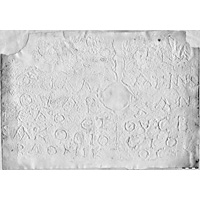 MAMA XI 8 (Apollonia)
MAMA XI 8 (Apollonia) 
Inscription recording the restoration of a church of the Archangel
- Type of monument:
- Inscription recording the restoration of a church of the Archangel.
- Location:
- Uluborlu (Apollonia): in the threshold of Bahçe Camii.
- Description:
- Plain limestone block. In the centre of the inscribed face, an incised Latin cross (Ht. 0.22), later defaced by a circular sinking (depth 0.015) and channel running from it to the top edge of the stone.
- Dimensions:
- Ht. 0.40; W. 0.67; Th. 0.24; letters 0.025-0.040.
- Record:
- Squeeze; line drawing; MB notebook copy (1956/92).
- Publication:
- MAMA IV 225; (Foss 1977: 285-8; SEG 27, 899); Labarre, Özsait, Özsait and Güceren 2012: 137-8, no.28.
- Date:
- AD 593/4 (Year 678 of Sullan era).
[ἀ]ν̣ανε̣οῦτε
τὸ παλάτιν
τ̣οῦ Ἀρχαν-
γέλου ἔτους ἑ-
5ξακοσιοστοῦ̣
ἑ̣βδομικοστ⟨ο⟩ῦ η̣´
The palace of the Archangel is restored, in the 678th year.





In line 6, the penultimate omicron was omitted by the mason. The reading of the final letter is uncertain; only a single vertical stroke can be seen clearly on the squeeze. For the combination of ordinal adjectives and numerals to indicate a date, cf. MAMA XI 80 (1956/36: Sebaste).
Foss 1977: 285-8 showed from the evidence of earlier dated inscriptions that the Sullan era was in use at Apollonia in the Roman imperial period (accepted by BE 1978, 39, and Leschhorn 1993: 274-6; for the dated inscriptions of Apollonia, see Leschhorn 1993: 501-2). This inscription is thus one of the very latest monuments to have been dated by the Sullan era; note also Drew-Bear 1978: IV 50 (SEG 28, 1130: Eumeneia, AD 563/4). The Aktian era was still in use at Philadelpheia in Lydia in the early sixth century (TAM V 3, 1882-4), and the Galatian provincial era was still in use at Ankara in AD 569/70 (SEG 42, 1163).
The ‘palace of the Archangel’ is likely to be a church (TIB Phrygien 387-8, s.v. Sōzopolis). No buildings of the sixth century have been recorded from Apollonia; the surviving fortifications are dated by Foss 1982: 152-7 to the eleventh and twelfth centuries.